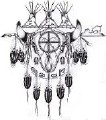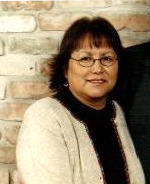
Spirit Lake Consulting, Inc.
Caring for Our People with Disabilities & Chronic Illness
"Making life better!"
 American Indian’s Final Transition: Life to Death
American Indian’s Final Transition: Life to DeathBy E. M. Klimpel (Hidatsa/Crow)
With assistance from Hazel Blake, Tribal elder
NOTE: This article refers to the Great Plains tribes, principally the Three Affiliated Tribes of Mandan, Arikara and Hidatsa. This information should definitely not be generalized to all tribes in the United States. These customs and beliefs are similar to some other Great Plains tribes. They may be completely different from other tribal groups, especially those outside of the Great Plains region.
Death is an issue that is seldom openly discussed in American society. However, if you are working with individuals with severe disabilities or chronic health impairments, your student/ client may be facing his or her own death. If you work in the schools, you may have to work with children in your classroom to understand the death of a fellow student. The better understanding you bring to the situation of the views and customs of the people you serve, the better services you will be able to provide.
American Indians are the largest minority in the state of North Dakota. The major contemporary tribal cultures of North Dakota are: Mandan, Hidatsa, Arikara, Lakota/Dakota and Turtle Mountain Chippewa. Other tribal members, not enrolled in a North Dakota tribe, are members of another tribe who have relocated, usually as a result of marriage or employment. Each of these tribes have their own language, customs and traditions. However, there are some commonalities among North Dakota tribes such as the extended family.
The “Indian Way”
Gillette (1991) has stated, “ The three most important parts of the Indian family are the children, the Elders and the extended family; the interactions between all the members of this family are what make the “Indian Way” different. The base of the Indian family is respect.
- Respect for God and Earth.
- Respect for the Elders.
- Respect for the other members of the family that are blood relations.”
Three Affiliated Tribes consider many more people to be a part of their family than do most other Americans. For example, first cousins are considered the same as brothers and sisters. The extended family is a way Indians use to cope with adversity. If the nuclear family has a problem, it is up to the extended family to help out (Gillette, 1991). Basically, the family takes care of its own and we are more likely to turn first to the family for support needs rather than formal services.
A sample of the extended family support system is when a family member is hospitalized and death is evident. The word is spread to notify the extended family. Family members from in and out of state come to pay their respects to the stricken member. They literally begin a bedside vigil and stay until the family member recovers or passes on. If the ill family member dies, the extended family immediately begins the procedure to send the spirit home in the “old way” This is true with the Hidatsa’s burial ceremony, which consists of a wake, church funeral, grave side ceremony, feast and concludes with a ‘giveaway’.
The “giveaway” tradition for the Hidatsa people plays a very important role in properly sending the spirit off to the other side. Hidatsa people believe in life after death. It is believed that the deceased family members come to take you back to the place of where we were before leaving to come to earth. Many tribal members near death talk of seeing these people. Once on the other side, there is a great celebration (Pow Wow) in honor of the person coming home. It is believed that the family member takes with him the food and gifts from his burial ceremony to have his own ‘giveaway’ on the other side. That is why the family brings the best of blankets, warbonnets (preferably a real eagle feather warbonnet) shawls, and plenty of food for the feast. So that he/she may have plenty to share with those who have passed on. For the living, it is the custom for the bereaved family to give, not those attending the funeral. After the feast, the gifts are given to those who have either paid respects to the deceased or provided quality care to the deceased and his/her family. In the old days, they might have received horses, cattle, saddles, yard goods and blankets. Today, the gifts consist of Pendleton blankets and/or beautifully sewn star quilts. Many North Dakota health care professionals, morticians and other human services personnel at one time or another are on the receiving end of the ‘giveaways’. Generosity has always been a strong trait of the Hidatsa people. Then the family spends a year of mourning for the deceased. They do not participate in any dances (Pow Wows). After that year, they hold a memorial service on the anniversary date of the death by the family. Once again, a ‘giveaway’ and feast is held to let the spirit go. The family is then free to participate in tribal activities.\
Gillette, B. (1991). North Dakota Native Americans, Native American experiences and developmental disabilities services. In A. Rousey & B. Gillette (Eds.) North Dakota Native Americans with developmental disabilities: Impressive programs/pressing needs. Minot ND: North Dakota Center for Disabilities 13-14.